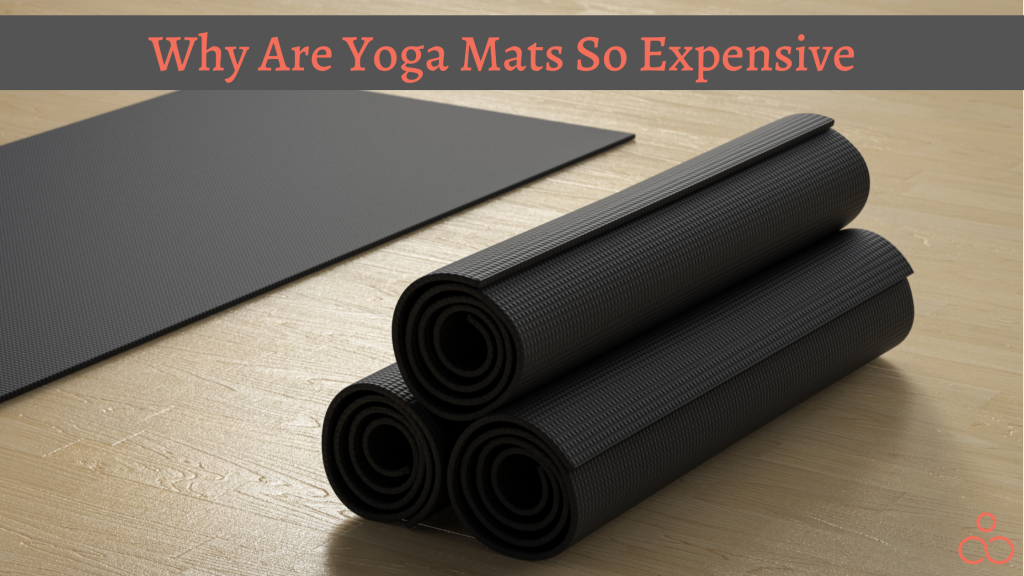Hundreds of different yoga mats might make it hard for you to decide which one to buy. Just like buying a perfect pair of jeans, where you need to put an effort into researching and finding the one that fits you the most. We are well aware of the fact that before buying a yoga mat a lot of questions might pop up into your head such as, what kind of yoga mat would be suitable for you, why are yoga mats so expensive or whether spending a lot of money on a yoga mat is worth it? Worry not, we’re here to give you insight into yoga mats and help you make the best decision for you.
About yoga mats

If you’re new to yoga, you might be wondering what kind of a mat to buy. Yoga mats are typically made of PVC or rubber, but there are also soft, breathable cotton mats available. Most of the yoga mats come with a bag to carry them in, which is handy. Yoga mats are specially designed to prevent your hands and feet from slipping during asanas (yoga poses). They’re also more comfortable and warmer for your hands and feet, and they’ll prevent you from slipping. A yoga mat is the ultimate way to stick to your regular yoga routine. It provides you with the optimum flexibility and convenience. No matter where you are, you can keep up with your yoga practice with ease.
Types of yoga mats

When it comes to yoga mats, there are a lot of options based on their quality. Let’s have a look at these mats that sets them apart and makes them unique in their own way:
Based on open-cell
It is usually a budget-friendly choice, but it comes with a downside – since it’s quite porous, it absorbs sweat, water, and other bodily fluids. This means you need to clean it regularly to avoid bacterial growth. But, it’s still cheaper than the closed-cell design.
Based on closed-cell
It is way denser and less porous, making them less absorbent. Plus, they’re more durable, so they’re usually used for more expensive, high-end mats.
Based on thickness
There are two options to choose from: 1/8″ and ¼”. The latter is a better choice, as it gives a more comfortable cushioning for your body when doing those intensive yoga workouts. In addition, these mats are more cost effective compared to the other types, so it’s a great option for starters.
Based on material
Natural rubber yoga mats are the perfect choice for eco-conscious yogis. They’re biodegradable, recyclable, and slip-resistant, which makes it easier to perform the difficult poses without slipping. Plus, their natural material provides excellent cushioning and durability, so you can keep enjoying your yoga sessions for longer.
Based on hygiene
The plastic elastomer mat provides excellent traction and is slip-resistant. Cleaning is a breeze, as it barely absorbs water or moisture. Best of all, it’s made from natural materials, so it won’t wear out with too much sun exposure.
Based on biodegradability
Jute fibers are great for yoga routines, they’re totally biodegradable and just as durable as those mats made of synthetic materials. Plus, the natural breathing quality of jute mats make them perfect for any kind of yoga routine.
Based on portability
For a convenient travel exercise session, the travel yoga mat is thinner than regular mats. Non-slip design ensures you won’t slip while performing yoga poses. It also folds and rolls up easily, so you can store it in your luggage without a problem. There are even yoga mats with their own bag, so you can travel fit and look stylish.
Do you really need a yoga mat?

It is generally recommended to have your own mat for yoga. It is important to have a sturdy hardwood surface to practice on, and a mat provides the needed cushioning to reduce the risk of any harm. An excellent yoga mat is essential for keeping your balance and having good posture. If you’re doing yoga and working up a sweat, you want a mat that’s grippy enough so you won’t slide around on it. Hence, we would like to suggest you have your own mat for yoga as it is really a smart move.
Why are yoga mats so expensive?

Have you ever wondered why yoga mats are so pricey? It’s because the materials used to make non-slip, long-lasting yoga mats are costly. Cheap yoga mats are typically made with polyvinyl chloride foam (PVC). As a result, they are often slippery, easily worn out, and can damage the environment. Sure, those pricey yoga mats might seem like a waste of money at first. But when you compare them to the cheaper mats, you’ll see that they offer much more in terms of durability, material composition, ease of movement, and slip resistance. Additionally, as a general rule, the more expensive the yoga mat, the better the materials used are, meaning that it tends to be more eco-friendly with a better grip. As you already know that yoga isn’t just about the poses, it’s about living in a way that doesn’t hurt the planet. That’s why yoga mats are important, especially if they’re made in an environmentally responsible way.
Reasons why yoga mats are so expensive
1. Provides durability
If you’re considering investing in your yoga journey, you can’t go wrong with splurging on a good-quality yoga mat. Sure, the upfront cost might feel like a lot, but it’s worth it in the long run. Cheap yoga mats can wear out quickly and may need to be replaced in a year or less – whereas a pricier mat could last you up to a decade! Quality mats are built to withstand the test of time and will be your trusty sidekick through your yoga journey, no matter how committed you are to the practice. So, why wait? Get yourself a high-end mat today and let it be your yoga companion for life!
3. Provides good grip
When it comes to yoga, stability is essential for effective practice. It’s worth the extra money to buy a mat that will keep you in place, so you don’t find yourself sliding or slipping while doing challenging poses. If you’re doing a lot of dynamic poses, an anti-skid mat is a must. You don’t need any extra obstacles in your practice, so it’s worth investing in a pricier option. It will make all the difference and help you stay steady.
4. Provides Eco-friendly quality
Investing in a pricier yoga mat can be beneficial in the long run, since you’ll likely get higher-quality materials. Eco-friendly mats are composed of biodegradable tree rubber, while those that are not eco-friendly are made from PVC. Furthermore, these mats are designed to last you a lifetime, meaning you won’t have to buy a new one or throw away your current one. You could even help the environment by choosing an eco-friendly mat!
5. Provides ideal thickness
Fancy yoga mats come in a wide range of thicknesses, from super slim 1mm to thick 8mm thicknesses. The thicker the mat, the more cushiony protection it gives your body while doing yoga. Yoga mats are specially designed to keep your joints safe, even during advanced yoga poses.
6. Provides sustainability
We all need to be more conscious of sustainability. Scientists and researchers are doing their part, so using sustainable products and living sustainably could be your contribution towards this drive. Now, more than ever, there’s a global push toward using sustainable products. Cheap yoga mats are made out of polyvinyl chloride foam, which isn’t the most eco-friendly option. By going for a high-end mat that’s made with sustainable materials instead – you’ll be making a great choice, and we’re here to give you a pat on the back for that!
7. Provides better alignment
Yoga mats equipped with alignment lines are a great tool for yogis of all levels, from beginners to experts. Not only do the lines help with posture, but they also make it easier to practice yoga on your own. The lines can also help to prevent overusing muscles and avoid injury. For those starting out with yoga, alignment lines are a must-have to ensure you’re doing it right!
8. Provides better sweat absorbent quality
Is your mat ready to sweat it out? Thanks to certain forms of yoga, you’ll likely be breaking a sweat during your session. That can lead to a dirty mat if it can’t handle the heat. A quality yoga mat should be able to withstand all the sweat, so you don’t have to deal with slipping yoga towels or a soggy mess.
9. Provides better portability
Expensive yoga mats usually have portability in mind when they’re designed, which can be especially helpful if you’re often on the move. Make sure that the mat can easily be rolled and folded; lower-quality mats can wear out quickly if they’re folded and rolled too often. Knowing the best way to roll and fold the mat can help it last longer and keep it clean. Plus, it doesn’t hurt to have a mat that you can take anywhere with you.
10. Provides better motivation
A cool-looking or vibrant yoga mat can be the perfect thing to get you out of bed each morning. It might be just what you need to get motivated to use it daily.
Factors that increase the price of yoga mat

Ever wonder why yogis swear by high-end yoga mats, even though they come with a hefty price tag? Here’s the scoop: there are a few key factors that jack up the cost of most yoga mats, but all the extra money is totally worth it in the end.
1. Biodegradable mat material
Material is a major factor in deciding the cost of a yoga mat. Cheap, low-grade yoga mats that contain polyvinyl chloride foam (PVC) are no doubt affordable, and lightweight but these mats do not last long and do not provide the support of other materials. Eco-friendly yoga mats are more costly than traditional mats, but they’re worth it! They’re crafted out of materials like recycled rubber, jute, and organic or natural cotton, which are chosen for their optimal performance and low environmental impact. Plus, they can be recycled when they reach the end of their life span, making them even more sustainable.
2. Long-Lasting Quality
Yoga mats are suitable for a wide array of fitness exercises. Some people exclusively utilize this gear for yoga postures and activities that physically emphasize balance and suppleness. Others may use the mat as a kind of pillow for their exercises. Since these mats are exposed to a large amount of force and compression, they must be extremely sturdy for maximum durability. If the yoga mats are not constructed from durable materials, such as recycled rubber, then they are liable to wear down more quickly and provide a very minimal cushion for your yoga or workout routines.
3. More cushioning
You won’t have to worry about discomfort while working out on pricier mats. They use ultra-dense material designs to provide optimal cushion and comfort. Plus, there’s the added bonus of having the right thickness for your exercise sessions.
4. Prevention from injury
The ideal yoga mat is usually around 1/8 inch thick or slightly thicker. Picking the correct thickness for your yoga mat is essential to maintain balance and avoid getting hurt. Inferior quality mats are typically thinner than 1/8 inch, which makes it more likely for your knees or other body parts to be injured due to the lack of cushioning.
5. Lifetime warranty
If you are looking for the perfect balance of mat thickness and cushioning for high-impact activity and compression, then you might want to invest in a top-of-the-line yoga mat. These mats come with a higher price tag, but many offer a lifetime warranty, which makes the cost more worthwhile over the long term. Put simply, if you want a mat that won’t let you down and will be around for years to come, then go for one with a warranty.
6. Antibacterial quality
After an intense yoga session, your mat can become a breeding ground for bacteria, especially if you don’t clean it regularly. That’s why the best yoga mat brands offer antimicrobial mats that help you stay clean and healthy. These mats are designed to reduce bacterial growth, so you can keep your mat in the best condition for longer and hit the mat with confidence.
7. Provides a firm grip
Having a firm grip is another must-have when it comes to yoga mats. A lot of them can get pricey because they have a non-slip surface or some kind of grippiness built into the material. Not only does this help prevent the mat from sliding around, but it also lessens the chances of injuring yourself while doing yoga.
8. Closed-Cell design
The closed-cell design is your best bet for long-term use. Not only do closed-cell mats last longer, but they’re also more hygienic and easier to clean. However, you’ll pay a bit more for the higher-quality mats.
6 things to keep in mind while buying an expensive yoga mat

1. Weight
If you’re planning on toting your mat around, it’s important to consider the weight. Thicker mats will definitely add more heft to your load, so think carefully about how much cushioning you need vs. how much carrying you’re willing to do.
2. Material
Confused about which yoga mat is right for you? Let’s break it down! Rubber mats are usually a more eco-friendly option since they’re made from natural, biodegradable materials. But, if you’re allergic to latex, the rubber may not be the best choice. PVC yoga mats are usually lighter and cheaper, but they can be a bit slicker than rubber. On the other hand, rubber mats tend to have a better grip. The decision is yours!
3. Stickiness
A good grip on your yoga mat is key! You don’t want to be slipping and sliding around while trying to get into your Warrior I. With a sticky mat, you can stay stable and keep your form while transitioning from pose to pose.
4. Eco-friendly
It is essential to be eco-friendly! As yogis, we should uphold the principle of ahimsa, or refrain from causing harm. Therefore, it is not ideal to use a yoga mat that will eventually become part of a landfill for many years.
5. Thickness
Not sure how thick your yoga mat should be? Well, it’s really a matter of preference. Go thinner if you want to feel close to the ground while in standing poses, or opt for a thicker type if you’re looking for something soft and supportive. If you have any joint or back sensitivities, a thicker mat might be a good fit.
6. Style
Time to have some fun! After you’ve checked off all the necessary boxes in terms of thickness, material, texture, stickiness, eco-friendliness, and price, the last step is getting a yoga mat you love the look of. Pick your favorite color, pattern, or print – after all, you’ll be seeing it a lot! Enjoy the shopping process, and have a great time in your next yoga session. Namaste!
Some of the best yoga mats of all time
1. Manduka pro Mat: It is a top pick among Ashtanga yogis! The ultra-dense design gives plenty of comfort and cushioning, while the closed-cell surface helps fend off moisture and bacteria. That means you’ll get more mileage and cleaning is a breeze.
2. The Manduka GRP series Mat: It is crafted from natural rubber, making it the perfect yoga mat for those who perspire a lot. It’s a favorite among Ashtanga yoga practitioners. The Manduka GRP yoga mat provides a superior grip with no slipping thanks to its leather-like texture and charcoal-infused rubber core.
3. The Manduka travel Mat: It is a ‘foldable and go’ mat that provides excellent portability. Stow it away in your laptop bag or place it over the yoga studio’s mat. The surface gives an excellent dry grip. It is formed from biodegradable, non-Amazon-collected, natural rubber tree materials with non-toxic foaming agents.
4. The splendiferous Liforme Mat: It has a natural rubber base, bolstered with a felt layer for added support and cushioning. Plus, its ‘AlignForMe’ system is an invaluable guide while honing your asana practice.
5. The CAP Barbell HHY-CF004G Fitness Yoga Mat: It is ultra-thin at 1/8″ thickness, so you can hit your poses in comfort – even on uneven ground. Don’t worry about slipping: the mat’s strong sliding resistance will keep you secure. Plus, it’s moisture-resistant so it’ll keep you dry and make cleaning a cinch. Your knees and elbows will thank you for this awesome mat!
6. The Lululemon Reversible Mat: It is like no other! It’s slightly thicker than regular mats, giving you extra cushioning for your joints during floor poses. Plus, its polyurethane top layer absorbs moisture so you don’t slip and slide in your sweatiest yoga sessions. And as a bonus, it even has an ‘antimicrobial additive’ that helps keep bacteria, mold, and fungi away. If you are interested in learning on how to clean a Lululemon Yoga mat, then click here.
7. The Gaiam Essentials Yoga Mat: It is perfect for yogis of all sizes – it’s extra-long at 72 inches and a quarter-inch thick to cushion your joints. Plus, its non-slip surface and textured finish provide superior traction and grip, so you can focus on your workout without fear of slipping or sliding. Get ready to sweat in style with this dual-sided mat – the fine texture helps keep it in place, so you can flow with confidence.
8. The CAP Barbell Yoga Mat: It is an ideal pick for those looking for a non-slip surface and exceptional slip resistance. Measuring 68″ long and 24″ broad, the rubber mat helps to protect the spine, knees, and elbows from tough flooring. It is also moisture-resistant, so sweat is easily wiped away, and it is incredibly easy to clean. Plus, it is 3mm thick, adding comfort and softness, while its lightweight design makes it ideal for travel.
9. Direct’s Yoga Mat: It has vertical and horizontal stripes that give you a great grip, while its foam composition is lightweight yet super durable. Plus, it’s 72 inches by 24 inches and 14 inches thick with a cushiony material to protect your elbows and knees. And best of all, it’s easy to keep clean!
10. Primasole Yoga Mat: It is a game-changer for yogis everywhere! It’s made of super sturdy PVC fabric and boasts those handy horizontal stripes for extra grip. Plus, the material won’t peel, fade, or tear, so you know it’s built to last. Plus, it’s light as a feather and measures 68 X 24 inches with a ¼” thickness to give you the support and cushioning you need. Plus, you won’t have to worry about a mess – it’s super easy to clean!
FAQ’s
Do you need a yoga mat on a carpet?
It’s not necessary, but it could be beneficial. It depends on the type of carpet you have and if it’s reliable. Ask a certified yoga instructor to be sure. Working out on a carpet every so often is perfectly fine, but don’t forget to use a yoga towel so you don’t damage the surface. Keep in mind that yoga mats are designed to prevent your hands and feet from slipping.
Do I need to clean my yoga mat?
It’s a good practice to give your yoga mat a good scrub after every couple of sessions, especially when it gets heavily sweat-stained. You can clean your mat with warm water and a bit of dish soap.
What’s the best yoga mat to buy without breaking the bank?
If you’re looking for decent quality, you should be looking to spend around $30-$50 for a TPE mat. But if you want something really special, you can get a natural rubber mat for between $60-$80.
Can I practice yoga without using a yoga mat?
No problem! Just make sure you know the benefits and drawbacks of ditching the mat. Depending on which poses you’re attempting, as well as your concerns about padding, space, cleanliness, and the environment, you may find yourself deciding that a mat is actually the best way to go.
What can you do with your yoga mat that is no longer needed?
You can put your old yoga mat that is no longer needed in various uses such as, you can use the mat for extra comfort when you’re in the laundry room or next to the kitchen sink, you can place it under your rug to keep it in place or keep it in your car as a sunshade to keep the heat out.
Conclusion
We think that splurging on an expensive yoga mat is worth it in the long run. Quality mats are far more durable than cheap ones, and if you’re an avid yoga practitioner, it’s essential to have the right mat. We advise considering your needs before making a purchase. All in all, investing in a high-end mat is a smart choice that will provide many years of comfort and stability.

